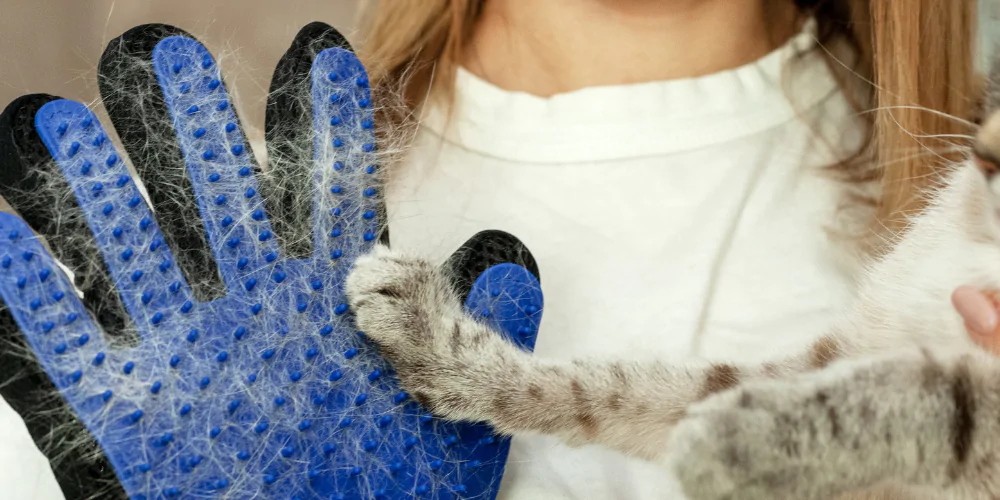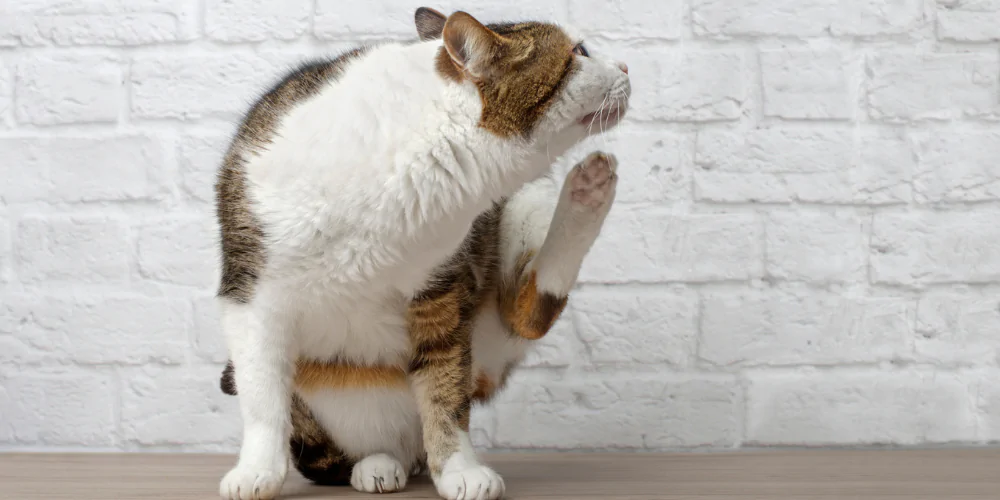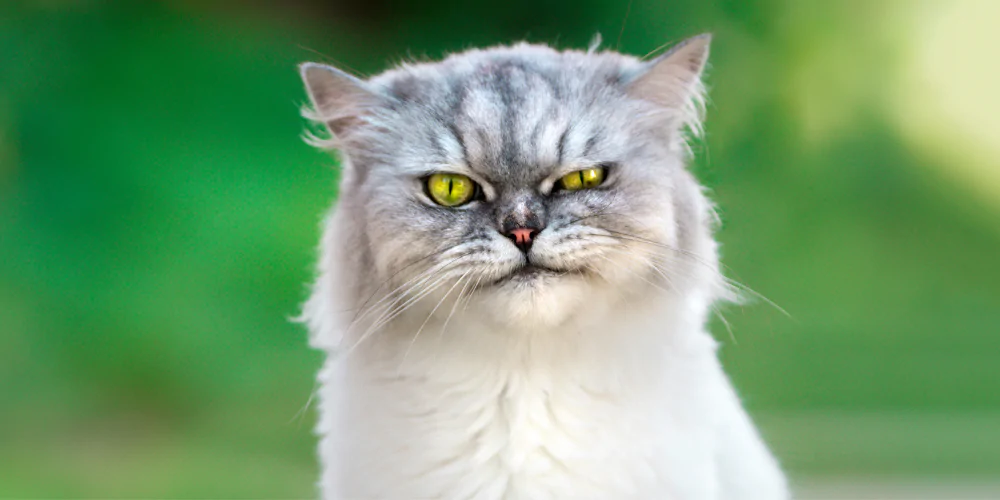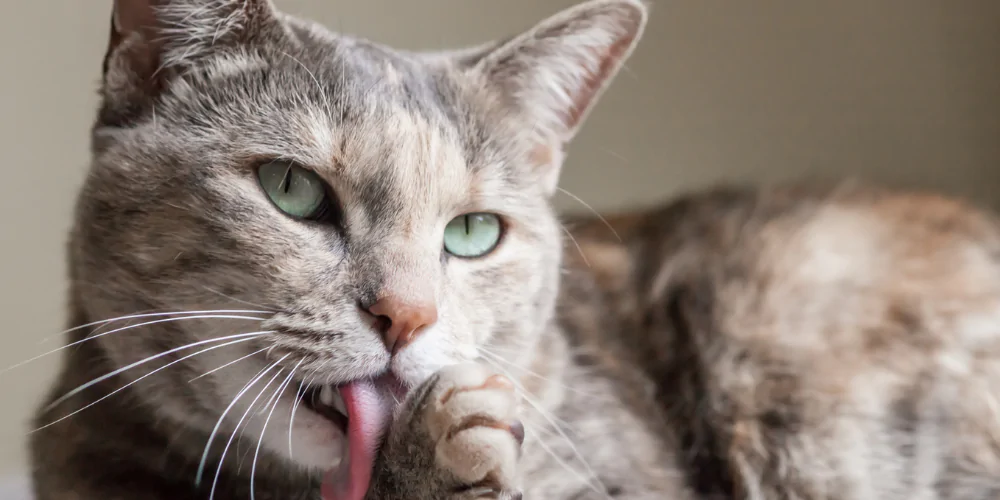
Why is my cat losing fur?

Dr Jessica May, FirstVet vet
3 August 2021 | 5 minutes read
Noticing that your cat is losing fur can be concerning for any pet owner. Fortunately, fur loss is very common and may be nothing to worry about.
To help reassure you, FirstVet vet Dr Jessica May discusses what you need to know about alopecia in cats.
Table of contents
- Alopecia in cats
> Cat alopecia causes - Cat fleas
> What are the flea treatments for cats? - Bald patches on cats
> Common causes of bald patches on cats
> What treatments are there for cat alopecia?
> Changes to routine and environment that cause cat fur loss - How to stop your cat from overgrooming

Alopecia in cats
Alopecia is common among cats and a common cause for a vet check-up. Generally, these cat alopecia causes are simple for vets to diagnose and treat to make sure your feline remains furry!
> Cat alopecia causes
There are several reasons why your cat may be experiencing some hair loss, including fleas, mites, ringworm infections, and changes in their environment.

Cat fleas
Is your cat scratching, licking their skin or has redness and irritation? If so, their fur loss may be due to fleas.
Fleas are extremely common and even the cleanest homes and cats can be hit with this problem. Flea allergy dermatitis is also not uncommon.
Thankfully, flea treatment for cats can be done from the comfort of your own home. It’s important to treat fleas quickly to prevent further problems such as tapeworms and diseases.
> What are the flea treatments for cats?
If you think your cat has fleas, FirstVet recommends:
- Regularly treating your cat with a prescription flea treatment. Please check with your vet for advice on what works best for your cat.
- Treating your home for fleas as 95% of the flea life cycle is in the environment and they can survive without a host for months.
- Cleaning bedding regularly and vacuum all furniture and floors to help destroy the fleas.

Bald patches on cats
Bald patches on cats can be stressful for pet owners, especially as they vary in size and appearance. If your cat is only losing fur in grooming spots and their skin looks healthy, the bald patches may be due to overgrooming.
> Common causes of bald patches on cats
- Mites: These can cause irritation through invading the skin. This can lead to itching, inflammation, and hair loss. Mites are highly contagious so should be treated as soon as possible.
- Ringworm infections: This is a fungal infection that feeds on the keratin in a cat’s fur, skin, and nails. This infection creates circular lesions on your cat’s skin, causing the hair to thin or fall out. Ringworm is also highly contagious and can be transmitted through direct contact with the fungal spores. The infection can also be passed between humans and animals (zoonotic).
> What treatments are there for cat alopecia?
- Fleas and mites are typically treated with ‘spot-ons’ but may also need a course of steroids to treat inflammation and itching. It can take three months to overcome these issues so early treatment and perseverance are important.
- Ringworm infections can be treated through shampoos or medicated ointments, baths or oral medication; this is to restrict and prevent fungus growth.
- Other treatments can include injections – which give symptomatic relief – and steroids to soothe itching.
> Changes to routine and environment that cause cat fur loss
If you’ve noticed that your cat is losing fur on their back legs or has a bald patch on their tail, it may be due to a stressor. Changes in routines and environments can trigger a cat into overgrooming. These can include:
- Absence of a family member. This can be due to separation anxiety caused by long working hours, holidays, departure for university, divorce or death.
- Getting a new pet or family member, such as a newborn baby.
- Moving homes.
- Moving the litter box.
- Rearranging furniture.
Overgrooming happens when cats spend a large amount of time grooming themselves, typically in the same spot. Cats often over-groom themselves when stressed as it offers a comforting sensation.
While some of these triggers are unpreventable, it’s important to keep an eye out for your feline and make sure they’re comfortable. But, if your cat does start overgrooming, there are plenty of things you can do to help them.

How to stop your cat from overgrooming
The best way to stop your cat from overgrooming is to find out what is causing them stress. Finding and eliminating the cause can help to improve your cat’s behaviour, meaning the overgrooming may gradually stop on its own.
Here are some things you can do to help ease your cat’s anxiety and stress:
- Ask absent family members to leave unwashed shirts or blankets. Their natural scent may help your cat to feel more comfortable in their absence.
- Slowly introduce your cat to any new family members – furry or human – to allow them time to adjust to the new environment.
- Play therapy can be a great stress reliever for cats. If moving to a new house or introducing a new person, play therapy can reinforce a positive experience in the new environment.
- Playing interactive games can have the best effect, so we recommend games like laser tag to get them actively involved with the new environment.
- Multiple litter trays (number of cats + at least one extra) and water sources.
- Water fountains.
- Litter trays away from high traffic areas/sheltered.
- Scratching posts.
- Places to hide indoors and out.
- Opportunity to be up high – marking by a window may suggest that they are stressed by high traffic or being overlooked, so frosting windows is also a good idea.
There are plenty of cat alopecia treatments to help bring your cat back to normal and make sure they’re happy and healthy. If you think your pet is sick, please contact your vet immediately.
Always consult a vet for any health-related questions about your pet. Our paw-some cat insurance gives you 24/7 unlimited access to FirstVet, a video calling service with fully-trained vets.


